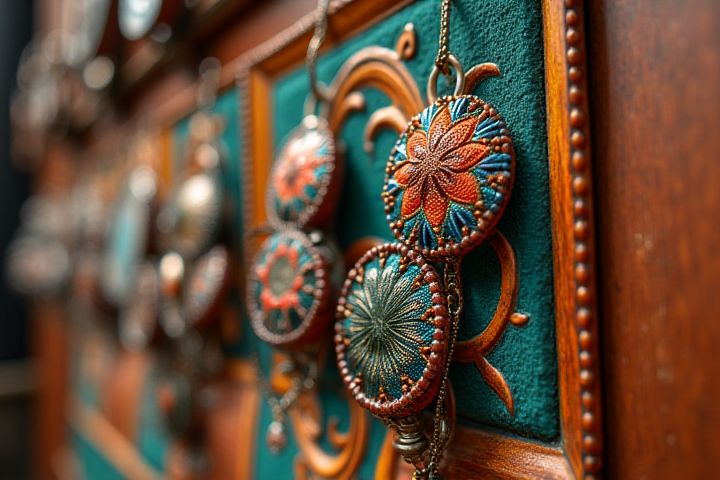
Nigeria boasts a rich tapestry of arts and crafts that reflect its diverse cultures and traditions. From intricate beadwork and colorful textiles to detailed wood carvings and vibrant paintings, these artworks often carry significant cultural narratives and symbols. Yoruba, Igbo, and Hausa are among the major ethnic groups contributing unique styles and techniques to the country's craft scene. Notably, traditional crafts like pottery and metalwork showcase generations of skill passed down through families. Engaging with these art forms not only connects you to Nigeria's heritage but also supports local artisans and their communities.
Adire fabric techniques
Adire fabric techniques are a vibrant expression of Nigeria's rich cultural heritage, characterized by intricate patterns and vibrant colors. Traditionally made using indigo dyeing, these fabrics showcase the craftsmanship of local artisans who employ techniques like tie-dye and batik. Each piece of Adire reflects unique stories and symbols, telling the narratives of the Yoruba people and their traditions. Engaging in the creation or appreciation of Adire textiles provides a profound connection to Nigeria's artistic legacy and promotes sustainable practices within the community.
Nok terracotta sculptures
Nok terracotta sculptures, dating back to 1000 BC to 300 AD, represent one of Nigeria's earliest and most significant art forms. Characterized by intricate designs and detailed facial features, these sculptures reflect the advanced craftsmanship and cultural sophistication of the Nok civilization. The sculptures, primarily made of clay, often depict human figures and stylized animals, emphasizing themes of spirituality and community. Engaging with these artworks can deepen your appreciation for Nigeria's rich artistic heritage and the historical narratives they embody.
Yoruba wood carving
Yoruba wood carving in Nigeria showcases intricate artistry and cultural significance, with artisans using traditional techniques passed down through generations. Characterized by detailed representations of deities, historical figures, and everyday life, these carvings reflect the rich traditions and beliefs of the Yoruba people. Each piece often utilizes locally sourced hardwoods, such as mahogany, which not only enhances durability but also highlights the natural beauty of the materials. By embracing this art form, you can delve into a rich history and appreciate the craftsmanship that embodies the essence of Yoruba culture.
Igbo uli body art
Igbo uli body art showcases intricate designs that represent cultural identity and heritage in Nigeria. This traditional form of art uses natural materials, such as clay and vegetable dyes, to create striking patterns on the skin. Often employed in significant ceremonies and festivals, uli art signifies beauty, status, and divine connection within the Igbo community. By embracing these expressive visuals, you contribute to the preservation and appreciation of Nigeria's rich artistic traditions.
Hausa leatherworks
Hausa leatherworks in Nigeria represent a rich cultural heritage, celebrated for their intricate designs and high-quality craftsmanship. Artisans skillfully create items such as traditional bags, sandals, and decorative pieces that showcase both functionality and artistry, often incorporating vibrant colors and motifs reflective of the Hausa identity. The process involves traditional techniques passed down through generations, using locally sourced leather and natural dyes. You can explore markets like Kurmi Market in Kano, where these exquisite leatherworks are prominently displayed, offering both a glimpse into the artistry and an opportunity to support local craftsmen.
Benin bronze casting
Benin bronze casting, a significant aspect of Nigerian arts and crafts, showcases the exceptional skills of the Edo people, particularly from the historic Benin Kingdom. This intricate technique involves lost-wax casting, allowing artisans to create detailed sculptures and plaques that often depict warriors, kings, or historical events. The bronzes not only serve as artistic expressions but also communicate the rich cultural heritage and societal values of the Benin Kingdom. Your exploration of these artifacts reveals their importance in understanding Nigeria's history and the global significance of African art.
Tiv traditional weaving
Tiv traditional weaving in Nigeria is a rich cultural practice that showcases intricate patterns and vibrant colors, reflecting the heritage of the Tiv people. Using locally sourced materials, artisans create beautiful textiles, featuring unique motifs that often tell stories of history and identity. The weaving process is not just a skill but an art form, passed down through generations, preserving the stories and traditions of the community. Engaging with this craft provides insight into Nigeria's diverse cultural landscape and highlights the importance of artisan skills in contemporary society.
Nupe glass beadmaking
Nupe glass beadmaking is a distinctive and traditional craft in Nigeria, predominantly associated with the Nupe ethnic group of Niger State. These beads, often intricately designed, serve various cultural purposes, including adornment and ceremonial displays. Artisans utilize a meticulous process of melting glass and forming beads, which reflects both skill and the rich cultural heritage of the community. Engaging with this craft not only provides insight into Nigeria's artistic landscape but also promotes sustainable practices through the use of locally sourced materials.
Esie stone figures
Esie stone figures are a prominent aspect of Nigeria's rich arts and crafts heritage, renowned for their intricate carvings and historical significance. These remarkable sculptures are believed to date back to the 12th century and showcase the artistry of the Yoruba people. You can explore these figures in museums across Nigeria, where they serve as a testament to the country's cultural diversity and craftsmanship. The Esie stone figures not only reflect artistic skills but also provide insights into historical traditions and beliefs of the Yoruba civilization.
Zaria art school influences
Arts and Crafts in Nigeria are significantly shaped by the Zaria Art School, which was founded in the 1950s and laid a critical foundation for modern Nigerian art. This institution emphasizes the integration of traditional techniques with contemporary practices, encouraging artists to explore cultural heritage while innovating in their work. The school's impact can be seen in various mediums, including textiles, ceramics, and painting, showcasing a vibrant tapestry of indigenous motifs and narratives. You can appreciate how this rich artistic lineage continues to inspire new generations of Nigerian artists, contributing to the country's evolving cultural identity.
